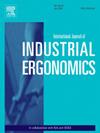Experimental investigation of submersible buoyancy regulation and support task performance under different levels of automation and varying workloads
IF 2.5
2区 工程技术
Q2 ENGINEERING, INDUSTRIAL
International Journal of Industrial Ergonomics
Pub Date : 2025-02-18
DOI:10.1016/j.ergon.2025.103713
引用次数: 0
Abstract
A submersible mechanical support operator is mainly responsible for monitoring and handling the submersible Buoyancy Regulation and Support (BRS) system. Operators are frequently faced uneven task frequencies due to unpredictable failures, leading to different Workload Level (WL) and potential safety risks. To enhance the task performance of submersible, this study explores adjusting the Level Of Automation (LOA) under different WLs to achieve effective allocation of human-machine functions. This study designed 7 LOAs (LOA1-LOA7) and recruited 36 subjects for experiments to analyze the impact of different LOAs and varying WLs on submersible BRS system task performance. This study primarily focused on determining the optimal LOA under three WLs by examining five key aspects, including subjective WL, work performance, Situation Awareness (SA), eye movement indicators, and Electrocardiogram (ECG). The results showed that under Low Workload Level (LWL), LOA2, LOA6, and LOA7 significantly improved work performance, but LOA6 and LOA7 resulted in a state of underload. Therefore, LOA2 was identified as the optimal LOA for LWL. Under Medium Workload Level (MWL), LOA4, LOA6, and LOA7 significantly improved both subjective WL and work performance. However, LOA6 and LOA7 also significantly reduced the SA levels of the subjects, making LOA4 the optimal LOA for MWL. Under High Workload Level (HWL), although LOA2 to LOA7 significantly improved the accuracy and response time, LOA6 and LOA7 notably reduced the subjective WL level and work time percentage. At LOA7, the subjects exhibited SA, the largest saccade amplitude, and the lowest saccade velocity. Therefore, LOA7 could be identified as the optimal LOA for HWL. The research findings underscore the importance of rationally considering dynamic function allocation strategy to enhance submersible operator performance under varying WLs.
不同自动化水平和不同工作负荷下潜水器浮力调节与支撑任务性能的实验研究
潜水机械支持操作员主要负责监测和操作潜水浮力调节和支持(BRS)系统。由于不可预测的故障,操作人员经常面临任务频率不均匀的问题,从而导致不同的工作量水平(WL)和潜在的安全风险。为了提高潜水器的任务性能,本研究探讨了在不同工作强度下调整自动化水平(LOA),以实现人机功能的有效配置。本研究设计了7种loa (lo1 - lo7),并招募了36名被试进行实验,分析不同loa和不同WLs对潜水式BRS系统任务性能的影响。本研究主要通过考察主观WL、工作表现、态势感知(SA)、眼动指标和心电图(ECG)五个关键方面来确定三种WL下的最佳LOA。结果表明,在低负荷水平(Low Workload Level, LWL)下,LOA2、lo6和lo7显著提高了工作绩效,而lo6和lo7则导致了低负荷状态。因此,LOA2被确定为LWL的最优LOA。在中等工作负荷水平(MWL)下,LOA4、lo6和lo7显著提高了主观工作负荷和工作绩效。然而,lo6和lo7也显著降低了受试者的SA水平,使LOA4成为MWL的最佳LOA。在高负荷水平(HWL)下,虽然LOA2到lo7显著提高了准确性和响应时间,但lo6和lo7显著降低了主观WL水平和工作时间百分比。在lo7时,受试者表现出SA、最大的扫视振幅和最低的扫视速度。因此,可以将lo7确定为HWL的最优LOA。研究结果强调了合理考虑动态功能分配策略对于提高潜器在不同水深下的性能的重要性。
本文章由计算机程序翻译,如有差异,请以英文原文为准。
求助全文
约1分钟内获得全文
求助全文
来源期刊
CiteScore
6.40
自引率
12.90%
发文量
110
审稿时长
56 days
期刊介绍:
The journal publishes original contributions that add to our understanding of the role of humans in today systems and the interactions thereof with various system components. The journal typically covers the following areas: industrial and occupational ergonomics, design of systems, tools and equipment, human performance measurement and modeling, human productivity, humans in technologically complex systems, and safety. The focus of the articles includes basic theoretical advances, applications, case studies, new methodologies and procedures; and empirical studies.

 求助内容:
求助内容: 应助结果提醒方式:
应助结果提醒方式:


